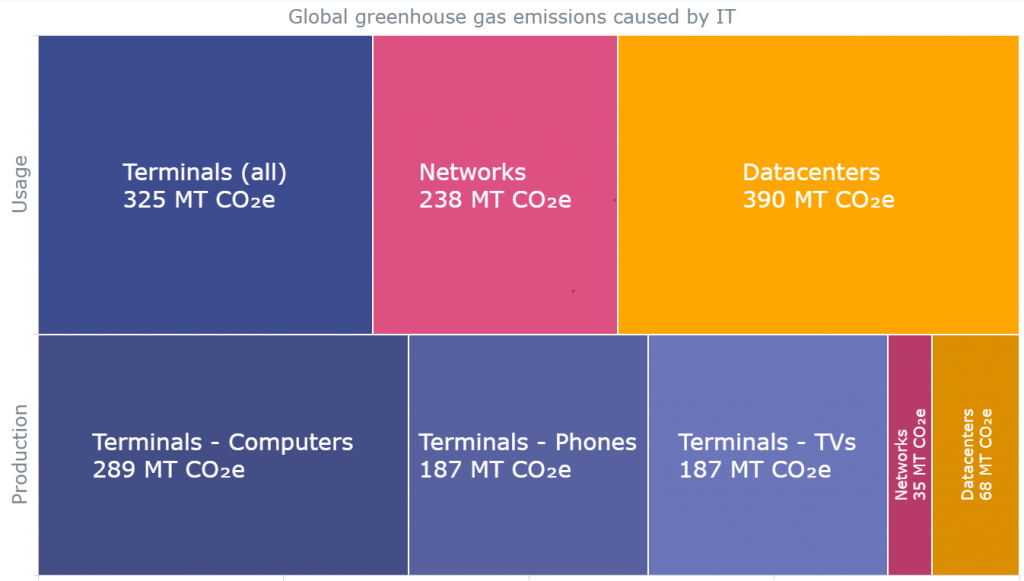Did you know that more than 4% of the environmental footprint of humanity originates from information and communication technologies, which is twice as much as air traffic?
In the current state of global climatic emergency, major efforts must be made in the IT sector to reduce humanity’s unsustainable environmental footprint, but how do we help without hindering performance and operational capacity?
The origins of the IT carbon footprint
Although the environmental impact of IT has many effects such as deforestation and toxic materials, our main focus in this article will be greenhouse gas emissions which are the main contributors of global warming. The most common of them is carbon dioxide (CO2), but some other gases we emit have much stronger effects. One such gas is CHF3, used primarily in the semiconductor industry, whose global warming potential is 14800 times that of carbon dioxide. A simple way to measure the effect of all greenhouse gases in a common referential is to use carbon dioxide equivalent (CO2e), where stronger and weaker effects in various gases are weighted accordingly. In terms of CO2e, a kilogram of CHF3 released in the atmosphere is then equivalent to 14800 kilograms of CO2.
IT equipments can be split into three categories, which all generate pollution during their production, use, then decommission :
- Data centers
- Telecommunication networks
- Terminals : computers, tablets, smartphones, …
The diagram below shows how the environmental impact is distributed between those categories during their life cycle :

Note that the end-of-life stage isn’t counted in this chart due to a scarcity of reliable global data.
As you can see, around half of the global CO2e emissions come solely from the production of electronics, and the large majority overall is due to home electronics.
The distribution of emissions during usage is more balanced than in production, but it’s not the case all the time: for some usages (such as video streaming on a smartphone) it’s estimated that the CO2e generated by the network and datacenter can be more than 200 times higher than the sole emissions generated by the terminal’s power consumption.
But how do I help?
As individuals, we all have a role to play for a world of greener IT. Here are a few suggestions of what you or your company can change towards sustainability:
- Consume less
This one is an obvious option, but it goes a very long way. Only buying electronic devices that you consider essential and renewing your hardware less often, are the key to reducing greenhouse gas emissions caused by manufacturing in addition to considerable financial savings.
At company-level, the Shift Project estimates that renewing corporate laptops every 5 years instead of 3 can reduce your carbon impact of terminals by 37%. The same amount of reduction can be achieved by making half of your employees owning a professional smartphone use the same device for personal and professional use.
- Be aware and raise awareness
The first step of change towards sustainability is realizing there’s a problem. Before diving into writing this article, I would never have expected the environmental impact of technology to be so shockingly high. By making others aware and being aware of the effects your consumption can have, you’re already making change by turning every decision of purchase or usage into a conscious act.
Without becoming a die-hard activist of green computing, here are a few things you could try to initiate for better awareness of the IT environmental footprint :
- Before launching a project which involves terminals and/or cloud computing, taking a moment to measure its environmental implications, and planning concrete actions to make them as small as possible. One of our clients in France even has a requirement to have this analysis performed in each tender bid, which I think is remarkable and can help improve a company’s image by a lot.
- Pushing your company to create a green IT dashboard which tracks environmental KPIs along with their CO2e : number of terminals replaced each week, live power consumption of cloud and network equipments, number of emails sent each day, etc.
- Sharing this article with your colleagues, friends and family (wink wink)
- Reducing the energy usage of your applications
If you work near the fantastic world of software development or computing infrastructure, you may have the opportunity to reduce directly the power consumption of your applications and hardware: implanting a datacenter in a colder region to reduce the need for artificial cooling, optimizing your algorithms to run faster with fewer resources, moving to green electricity, … Currently, most of the work is done at datacenter-level, and people tend to forget that application is what ultimately consumes energy. Here at Sogeti, we are embracing this new horizon of optimization with several initiatives such as Green Testing which is available to our clients.
You will also notice that most of the times a sustainable system is also less costly, so that’s one more argument in favor of green IT!
Thanks for reading and sharing this article. You have all my contact info below, I’d be glad to have fruitful discussions about the topic and give more advice to anyone who needs it.
Sources and recommended resources:
- https://www.electricitymap.org/map
- https://ictfootprint.eu/
- https://theshiftproject.org/wp-content/uploads/2019/03/Lean-ICT-Report_The-Shift-Project_2019.pdf
- https://www.ipcc.ch/site/assets/uploads/2018/02/ar4-wg1-chapter2-1.pdf
- https://www.researchgate.net/publication/275653947_On_Global_Electricity_Usage_of_Communication_Technology_Trends_to_2030

 English | EN
English | EN 